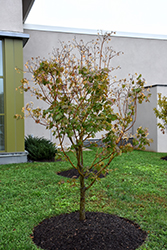It's all about ...
plants

Mikasa Yama Siebold Maple
Acer sieboldianum 'Mikasa Yama'
Height: 20 feet
Spread: 15 feet
Sunlight:
![]()
![]()
Hardiness Zone: 4a
Other Names: Mikasayama Siebold Maple
Description:
A lovely, refined small tree from the Japanese maple family, similar in many respects; silky new foliage matures to bright green; fall color is yellow-gold, tinged with orange and red; an outstanding feature tree for smaller landscape areas
Ornamental Features
Mikasa Yama Siebold Maple features dainty corymbs of yellow flowers along the branches in early spring. It has green deciduous foliage which emerges chartreuse in spring. The serrated lobed palmate leaves turn outstanding shades of yellow, orange and crimson in the fall.
Landscape Attributes
Mikasa Yama Siebold Maple is a deciduous tree with an upright spreading habit of growth. Its average texture blends into the landscape, but can be balanced by one or two finer or coarser trees or shrubs for an effective composition.
This is a relatively low maintenance tree, and should only be pruned in summer after the leaves have fully developed, as it may 'bleed' sap if pruned in late winter or early spring. It has no significant negative characteristics.
Mikasa Yama Siebold Maple is recommended for the following landscape applications;
- Accent
- Shade
- Hedges/Screening
Planting & Growing
Mikasa Yama Siebold Maple will grow to be about 20 feet tall at maturity, with a spread of 15 feet. It has a low canopy with a typical clearance of 3 feet from the ground, and is suitable for planting under power lines. It grows at a slow rate, and under ideal conditions can be expected to live for 60 years or more.
This tree does best in full sun to partial shade. It prefers to grow in average to moist conditions, and shouldn't be allowed to dry out. It is not particular as to soil pH, but grows best in rich soils. It is somewhat tolerant of urban pollution. Consider applying a thick mulch around the root zone in winter to protect it in exposed locations or colder microclimates. This is a selected variety of a species not originally from North America.
This plant is not reliably hardy in our region, and certain restrictions may apply; contact the store for more information.
